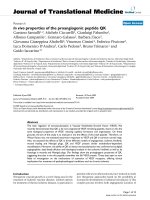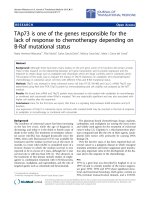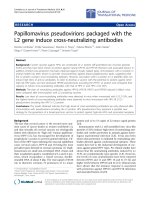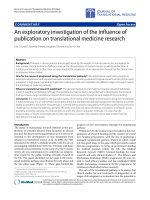báo cáo hóa học:" Clinical Translation Section: Accelerating the Pace from Bench to Bedside" potx
Bạn đang xem bản rút gọn của tài liệu. Xem và tải ngay bản đầy đủ của tài liệu tại đây (117.24 KB, 1 trang )
EDI T O R I A L Open Access
Clinical Translation Section: Accelerating the Pace
from Bench to Bedside
Lana E Kandalaft
*
and George Coukos
Editorial
Cell and gene therapy clinical trials have been conduct ed
for various indications such as cancer, cardiovascular dis-
eases an d autoimmune disorders for more than 20 years.
The increased understanding of immune function, cancer
biology, and stem cell bi ology have dra matically accelerated
the development of technology for cell and gene therapy in
these areas. Supported by some successful clinical results,
the development of many potent ial new technol ogies has
produced an explosion of therapeutic pursuits in the clinic.
The new technologies have produced significant challenges
in the clinical translation space, including the need to
develop innovative clinical trial designs, to acc elerate devel-
opment of therapies by minimizing the number of patients
required to evaluate safety and e fficacy; to develop and
incorporate methods to capture important biologic effects
of cell and/or gene based therapies in patients; and to dis-
sect the impact of therapeutic combinations. Furthermore,
the increasingly personalized flavor of cell and gene thera-
pies has produced an ever-greater need for developing reli-
able biomarkers for selecting patients and measuring
biologic effects of therapy. Finally, regulatory agencies have
recognized the need for modifying acceptable evaluation
metrics to respond to the increasing complexity in clinical
design and interventions. Yet, despite significant advance-
ment in the field, progress remains slow relative to discov-
ery and the need of speeding up clinical application of
basic science d iscoveries is st ill un met. Indee d, the rapid
advancement of therapeutic technologies in the laboratory;
the plethora of biomarker candidates; and the recent inno-
vations in clinical science concerning trial design, contrast
with the slow development process from conception of an
idea till proof of concept in the clinic. Typically, clinical
trials of this nature take several years t o develop, imple-
ment, complete and report. This creates a significant gap
of knowledge in the field, as clinical innovation takes sev-
eral years to be communicated.
The incessa ntly evolving field of cell and gene therapy
requires e arly rapid and extensive communication to ensure
continuing progress. The goal of JTM ‘Clinical Translation
Section’ is to provide a new space for the rapid communica-
tion of innovative early p hase clinical trials, where novel
scientific ideas are translated to the clinic, at the time of
initiation of a clinical study. These include investigator-
initiated as well as industry-sponsored clinical trials, which
have completed the regulatory process and are about to
start accruing patients. No clinical results are required.
These “wh ite papers” review the background, r ationale, clin-
ical design and approach, translational endpoints and
expected outcomes of a n ew clinical trial in a scholarly man-
ner, and provide the opportunity to investigators to share
their views and clinical translation efforts with a wide audi-
ence at an early stage, which could benefit greatly other
investigators in the field. Such therapies will target a range
of diseases including cancer, cardiovascular diseases, auto-
immune disorders or other common or rare diseases where
cell-based, gene-based, biological or otherwise t argeted t her-
apy i s a pplied. A broad-based and multidisciplinary editorial
board stemming from academia, biotech and pharma with
expertise i n cancer immunotherapy; cellular manufacturing;
gene therapy; stem cells; regenerative m edicine; cardiovascu-
lar medicine; and autoimmunity will evaluate manuscripts.
Accepted manuscripts will be distinguished for the novelty
in approach, design or clinical indication of the study and
unique ability to translate laboratory concepts from the
bench to the bedside. Lastly, this section will also provide a
platform for earlier academic recognition of the significant
efforts of translational clinical investigators whose careers
primarily depend on the execution of clinical tri als.
Received: 10 June 2011 Accepted: 21 July 2011 Published: 21 July 2011
doi:10.1186/1479-5876-9-116
Cite this article as: Kandalaft and Coukos: Clinical Translation Section:
Accelerating the Pace from Bench to Bedside. Journal of Translational
Medicine 2011 9:116.
* Correspondence:
Ovarian Cancer Research Center, University of Pennsylvania, Philadelphia, PA
19104, USA
Kandalaft and Coukos Journal of Translational Medicine 2011, 9:116
/>© 2011 Kandalaft and Coukos; licensee BioMed Central Ltd. This is an Open Access article distributed under the terms of the Creative
Commons Attribution License ( which permits unrestricted use, distribution, and
reproduction in any medium, provided the original work is properly cited.









